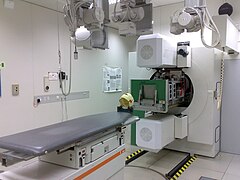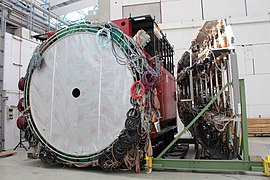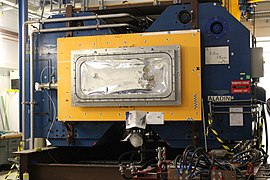GSI Helmholtz Center for Heavy Ion Research
| GSI Helmholtz Center for Heavy Ion Research | |
|---|---|
 GSI Helmholtz Center for Heavy Ion Research |
|
| Category: | Large research facility |
| Consist: | Date of establishment: 1969 |
| Membership: | Helmholtz Association |
| Facility location: | Darmstadt |
| Branch offices: | Helmholtz Institute Jena , Helmholtz Institute Mainz |
| Basic funding: | Budget: 113 million euros |
| Management: | Professor Dr. Paolo Giubellino (Scientific Director) Dr. Ulrich Breuer (administrative management) Jörg Blaurock (technical management) |
| Employee: | 1400 |
| Annotation: | Legal form: GmbH |
| Homepage: | www.gsi.de |
The GSI Helmholtz Center for Heavy Ion Research in Darmstadt is a research facility that was founded in 1969 as the Society for Heavy Ion Research (GSI) to conduct research on and with heavy ion accelerators . It is the only major research facility in Hesse .
Company details
The shareholders of GSI are the Federal Republic of Germany with 90 percent, the federal state of Hesse with 8 percent and the federal states of Rhineland-Palatinate and Thuringia with 1 percent each. The center is a founding member of the Helmholtz Association of German Research Centers .
The GSI received its current name on October 7, 2008 to help raise awareness of the Helmholtz Association, which was founded by the major German research institutions, nationwide and internationally.
Large appliances
The GSI Helmholtz Center for Heavy Ion Research maintains several accelerator facilities:
- The UNILAC is a linear accelerator that can accelerate ionized atoms ( ions ) up to around 20% of the speed of light . A large number of experiments are already possible with ions in this energy range, which have led to the discovery of the superheavy elements Bohrium , Hassium , Meitnerium , Darmstadtium , Roentgenium and Copernicium with atomic numbers 107 to 112. In addition, the UNILAC serves as an injector for the
- SIS18 , a synchrotron that can accelerate ions up to 90% of the speed of light (corresponding to a magnetic stiffness of 18 Tm);
- The ESR is a storage ring which , if required, can absorb and store the ions accelerated by the SIS.
- The Cryring is a storage and accelerator ring with its own ion source and its own linear pre-accelerator provided by Sweden as part of the FAIR project . Independent experiments can be carried out on it and equipment for the FAIR project can be tested. It is about half the size of the ESR and is also connected to it so that it can be supplied with particles from there.
In addition, a number of large experimental facilities were / are operated. These include:
- SHIP , an electromagnetic velocity filter for the separation and identification of products from the fusion of cores, the super-heavy elements;
- FOPI , a large particle detector for research into the physics of nuclear reactions;
- HADES , a di-electron spectrometer for investigating the properties of hadrons, especially at high pressures and temperatures;
- the FRS (fragment separator ), which can be used to generate radioactive isotopes and various fission and fusion products;
- HITRAP , an experimental facility for decelerating and storing highly charged ions;
- a radiation station for tumor therapy with accelerated carbon ions;
- participation in the ALICE - detector of the European Research Center CERN .
In addition to the ion accelerators and large-scale experiments, the GSI Helmholtz Center for Heavy Ion Research has two high-energy laser systems for generating hot and dense plasmas:
- nhelix achieved services up to 10 gigawatts ( N anosecond H igh E nergy L aser for Heavy I on E x periments) ;
- PHELIX is the "big brother" of the nhelix and to power up to a Petawatt provide ( P etawatt H igh E nergy L aser for Heavy I on e x periments) .
The Green IT Cube, which was inaugurated in 2016, serves as the building for a data center for data analysis.
Research areas
The experimental facilities set up at the GSI Helmholtz Center are operated in cooperation with around 1200 researchers. The focus is on atomic and nuclear physics , plasma physics , biophysics and materials research .
The synthesis and detection of the elements Bohrium (in 1981), Meitnerium (1982), Hassium (1984), Darmstadtium (1994), Roentgenium (1994) and Copernicium (1996) are among the great successes of the Society for Heavy Ion Research at that time . In addition, with heavy ion therapy, a treatment method against malignant tumors was developed and tested.
- Examples of experiment stations / detectors at GSI
Treatment center for heavy ion therapy with a sample mask for the radiation of brain tumors
Gamma radiation detector for the R3B land experiment (investigation of the properties of exotic nuclei)
history
On the initiative of the Hessian universities in Darmstadt , Frankfurt and Marburg , the GSI-Helmholtz Center was founded as the Society for Heavy Ion Research (GSI) on December 17, 1969. A forest in the north of Darmstadt was chosen as the location. The construction cost about 180 million DM. The UNILAC developed by Christoph Schmelzer , 1971 also the first managing director of GSI, was realized as the first part of the accelerator facility. The facility delivered the first ion beams for experiments from 1975 onwards.
In the 1980s, the UNILAC beam was used at GSI to synthesize several super-heavy elements for the first time. At this time, the SIS18 ring accelerator and the ESR experimental storage ring were also planned, implemented and finally put into operation in 1990. Scientific directors at the time were Gisbert zu Putlitz (1978–1983) and Paul Kienle (1984–1992). Already under Paul Kienle's successor Hans Joachim Specht (1992–1999) a discussion began about the further expansion of the accelerator facilities and experimentation possibilities at the GSI, which was included in the project proposal for the Facility for Antiproton and Ion during Walter Henning's tenure (1999–2007) Research (FAIR) culminated. From 2007 to 2015 Horst Stöcker was Scientific Director of GSI. He was followed by the trio Ursula Weyrich, Jörg Blaurock and Paolo Giubellino as joint managing directors of GSI and FAIR.
The International Accelerator Center FAIR
In February 2003 the federal government promised that 75% of the expansion of the GSI Helmholtz Center for Heavy Ion Research into an international accelerator center for research with ion and antiproton beams (Facility for Antiproton and Ion Research) would be financed by Germany. 65% come from the federal government, 10% from the state of Hesse. The remaining 25% of the costs are to be borne by international partners Finland , France , India , Poland , Romania , Russia , Spain , Sweden and Slovenia . The total costs are estimated at 1.262 billion euros (2005 price level).
In November 2007, a physicist symposium and an event took place in Darmstadt, during which a communiqué about the joint establishment of FAIR was published by those involved in the planning. On October 29, 2012, representatives of the city of Darmstadt presented FAIR GmbH with the building permit for the construction of the new large-scale research facility. A large part of the plant is scheduled to go into operation in 2022, with full operation planned for 2025.
The core element is a double ring accelerator (SIS 100/300) with superconducting magnets. This will come to a circumference of 1,083.6 m. The existing GSI facility with the SIS 18 heavy ion synchrotron serves as a pre-accelerator for the new FAIR accelerator complex. At its center is the synchrotron double ring system SIS 100 and SIS 300. These are followed by: the high-energy storage ring HESR, the collector ring CR and the recycled experimental storage ring RESR, the new experimental storage ring NESR and the Super-Fragment-Separator Super-FRS . Up to five large research programs with different requirements can be carried out in parallel. Due to financial framework conditions, only SIS 100, HESR, CR and Super-FRS as well as a measuring hall with experiments on a fixed target for nuclear matter studies can initially be realized from the planned components ( modularized start version ).
The project aims to provide new insights into the structure of matter and the evolution of the universe , but also to work in the field of application and innovation. The facility is to use high-energy ion beams to gain knowledge about the formation of the heavy elements and to clarify fundamental questions about the strong force between the elementary building blocks of matter. In addition, by generating a quark-gluon plasma, a state of matter is to be investigated more closely that existed for a short time fractions of a second after the Big Bang when the universe was formed. Decelerated antiprotons enable the measurement of anti-atoms ( anti-hydrogen ) as with the Antiproton Decelerator . From this, the physicists hope to draw conclusions about symmetry violations in the natural laws of our world and a world that consists of antimatter . The experimental program at FAIR is therefore based on four subject areas: Nuclear structure, nuclear astrophysics and reactions ( NuSTAR collaboration ), nuclear matter ( baryon ) experiments ( CBM collaboration ), hadron physics ( PANDA collaboration ) as well as experiments from atomic, plasma, material research and Biophysics ( APPA collaboration ).
Structurally, the Facility for Antiproton and Ion Research is an independent GmbH , whereby the first shareholders of the GmbH were Germany, Russia, India, France, Poland, Romania, Slovenia and a Swedish- Finnish consortium . After receiving financial contributions from abroad, FAIR GmbH was founded on October 4th, 2010. The first scientific director of FAIR was Boris Sharkov . Since January 1, 2017, Paolo Giubellino has been the first joint scientific managing director of FAIR and GSI.
Milestones
- 1966: Foundation of the Nuclear Physics Working Group Hessen (KAH)
- 1969: Foundation of the Society for Heavy Ion Research
- 1970: Start of participation in the working group for large research facilities (AGF)
- 1975: First experiments at the UNILAC linear accelerator
- 1981–1984: Synthesis and discovery of the first new chemical elements (107–109)
- 1990: Commissioning of the ring accelerator SIS-18 and the storage ring ESR
- 1994–1996: Synthesis and discovery of the elements with ordinal numbers 110–112
- 1997: First patient treatment with carbon ions at the GSI therapy center
- 2001: Draft submitted for the new FAIR accelerator center
- 2007: Official start of the FAIR project
- 2008: The high-energy laser system PHELIX goes into operation
- 2008: The Society for Heavy Ion Research is in GSI Helmholtz Center for Heavy Ion Research GmbH renamed
- 2009: Founding of the Helmholtz Institute Jena (with the Friedrich Schiller University Jena and DESY ) and the Helmholtz Institute Mainz (with the Johannes Gutenberg University Mainz ) as branches of the GSI
- 2010: The sixth element found at GSI is baptized with the name Copernicium
- 2010: The contract for the establishment of FAIR GmbH for the realization of the FAIR project is signed, GSI is one of the main shareholders
- 2016: The new IT Green Cube data center goes into operation; the associated computer system L-CSC was on the world ranking list of the most energy-efficient high-performance computers "Green 500" until June 2015 in first place
Others
Since 1992 the GSI has been using a code from the neighboring town of Messel . When switching to four-digit extension numbers, it became necessary to obtain a two-digit telephone number , which was no longer possible in the Darmstadt network. Maintaining a three-digit number would have resulted in more than 16-digit number combinations and would have overwhelmed the possibilities in the international direct dialing traffic of the time.
literature
- Gottfried Munzenberg, Matthias Skull: Modern Alchemy - The hunt for the heaviest elements. Braunschweig / Wiesbaden 1996, ISBN 3-528-06474-9 .
Web links
- Homepage of the GSI Helmholtz Center
- Detailed information about FAIR in the world of physics
- Homepage of the Facility for Antiproton and Ion Research in Europe GmbH (FAIR GmbH)
Footnotes
- ↑ a b Facts and figures about GSI , accessed on October 28, 2017
- ↑ a b c d Management of GSI and FAIR. Retrieved January 20, 2020 .
- ↑ a b New director at the accelerator center. In: pro-physik.de. September 22, 2016, accessed January 21, 2020 .
- ↑ GSI Helmholtz Center for Heavy Ion Research: Dr. Ulrich Breuer is the new Administrative Director of GSI and FAIR. March 16, 2020, accessed June 16, 2020 .
- ↑ Markus Bernards: Jörg Blaurock is the new Technical Director of the particle accelerators FAIR and GSI. Press release. In: idw-online.de. February 12, 2016, accessed January 21, 2010 .
- ↑ shareholders of GSI are the federal government to 90 percent, the state of Hessen to eight percent, the state of Rhineland-Palatinate and Thuringia to each one percent. They are represented on the supervisory board by the Federal Ministry of Education and Research (BMBF) and the respective state ministries.
- ↑ Resonator podcast of the Helmholtz Association : GSI in Darmstadt (episode 35, June 27, 2014)
- ↑ Press release of the GSI Helmholtz Center for Heavy Ion Research from October 20, 2008
- ↑ The heavy ion storage ring ESR on the GSI website; accessed on August 6, 2018
- ↑ Cryring on the GSI website; accessed on August 6, 2018
- ↑ heise online: Green IT Cube: Highly efficient supercomputer domicile inaugurated. In: heise online. Retrieved January 24, 2016 .
- ↑ Explanation: At the top right the optics of the nhelix laser beamline. The focusing PHELIX laser beam comes from the top left; from the picture (small tube below) the ion beam of the UNILAC.
- ↑ GSI history - a research laboratory for everyone. Retrieved September 7, 2019 .
- ↑ Former management of the GSI Helmholtz Center for Heavy Ion Research
- ↑ Change at the top of the GSI. March 13, 2015, accessed January 21, 2020 .
- ↑ Mistress of the merger. In: pro-physik.de. November 3, 2014, accessed January 21, 2020 .
- ↑ New management for accelerator project. In: pro-physik.de. February 19, 2016, accessed January 21, 2020 .
- ↑ a b Facts and figures on the FAIR project. Retrieved September 7, 2019 .
- ^ Starting shot for the international accelerator center FAIR at the GSI. Press release from the GSI Helmholtz Center for Heavy Ion Research from November 7, 2007
- ↑ Particle accelerator FAIR receives building permit. idw-online from October 29, 2012
- ↑ Overview of experimental collaborations at FAIR
- ↑ Press release about the state treaty and the establishment of FAIR GmbH
- ↑ Paolo Giubellino , accessed August 12, 2019.
- ↑ New energy-efficient high-performance data center for GSI and FAIR - Inauguration of the Green IT Cube on January 22, 2016, accessed on March 2, 2016
- ↑ SPALADIN website (in Engl.)
- ↑ The heavy ion storage ring ESR. Retrieved September 7, 2019 . Electron Cooling Section
- ↑ Electron cooler on SIS18, ESR, CRYRING. GSI Helmholzzentrum für Schwerionenforschung GmbH, accessed on September 14, 2019 .
Coordinates: 49 ° 55 ′ 53 " N , 8 ° 40 ′ 45" E
















